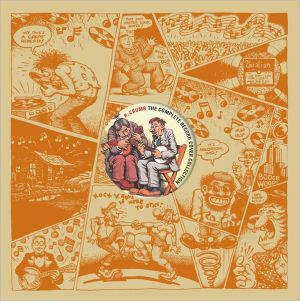- Comics
- Comics Reviews
- Manga
- Comics Reviews
- European Comics
- News
- Comics News
- Press Releases
- Columns
- Spotlight
- Digital Comics
- Webcomics
- Cult Favorite
- Back Issues
- Webcomics
- Movies
- Toys
- Store
- More
- About
By Leroy Douresseaux
November 9, 2011 - 09:57
 |
| The Complete Record Cover Collection cover image, which is designed to resemble an LP in a cardboard sleeve. |
R. Crumb (also known as Robert Crumb) is the famed Underground Comix creator and artist known for his controversial work. He is a perverse social critic, as seen in such work as the wickedly funny “When the Niggers Take Over America!” He is also an accomplished illustrator and artist capable of non-controversial work, as seen in the 2010 paperback, The Sweeter Side of R. Crumb. Crumb was recently a New York Times bestseller with The Book of Genesis Illustrated by R. Crumb.
Crumb has still another side, which is collected in The Complete Record Cover Collection, a new hardcover Crumb art book from publisher, W.W. Norton & Company. Crumb is a prolific illustrator of record covers, having produced over 400 of them. Crumb apparently began drawing record covers in 1968 when Janis Joplin asked him to draw the cover for Cheap Thrills (1968), the second album from American rock band, Big Brother and the Holding Company, for which she was then the lead singer.
The publisher says that The Complete Record Cover Collection is the complete catalog of every record cover jacket Crumb has ever drawn, while also admitting that there could still be Crumb music-related art hidden away somewhere. Crumb mainly drew record covers for artists, new and forgotten, who performed jazz, country, old-time blues, roots, and Americana music of the 1920s and 30s. He also produced record cover art for his own musical act, R. Crumb and His Cheap Suit Serenaders.
The Complete Record Cover Collection also brings together other music related art from Crumb. The book reprints art for event flyers and posters, advertisements, magazine covers, silkscreen prints, and trading cards, among other things. Much of the work also reveals Crumb’s skill at lettering. I think the publisher would like reviewers to emphasize the record cover art in their reviews of The Complete Record Cover Collection, but I want to focus on something else.
What I like most about this book are the portraits of musicians – past and present. These drawings range in size from about 2.5” x 4” to a little larger. They are drawn with such power and faithfulness to the subjects that they seem larger. Crumb executed two such portraits of legendary R&B singer James Brown for The New Yorker in 2000. One depicts a young Brown that captures his likeness with a photographer’s touch. The other, a depiction of an older “hardest working man in show business,” is more of a cartoon, but it captures the spirit both of Brown’s public persona and of his stage performance. Crumb’s 1992 portrait of Frank Zappa (also for The New Yorker) is a sparkling psychedelic piece that encapsulates the eccentric Zappa.
These black and white ink drawings are rendered in such detail that Crumb’s cartoonish style has a kind of realism that is all his own. Crosshatching, fine line work, and solid brushwork bring these musicians to life in strange ways, making even what is familiar about them vibrant and new. This is exemplified in portraits of a smirking, older George Jones; a proud Bo Diddley, and a wired up Merle Haggard.
The Complete Record Cover Collection is about the record cover art of R. Crumb, and it is an excellent book in that regard. Its treasure, however, is the collection of portraits.
A